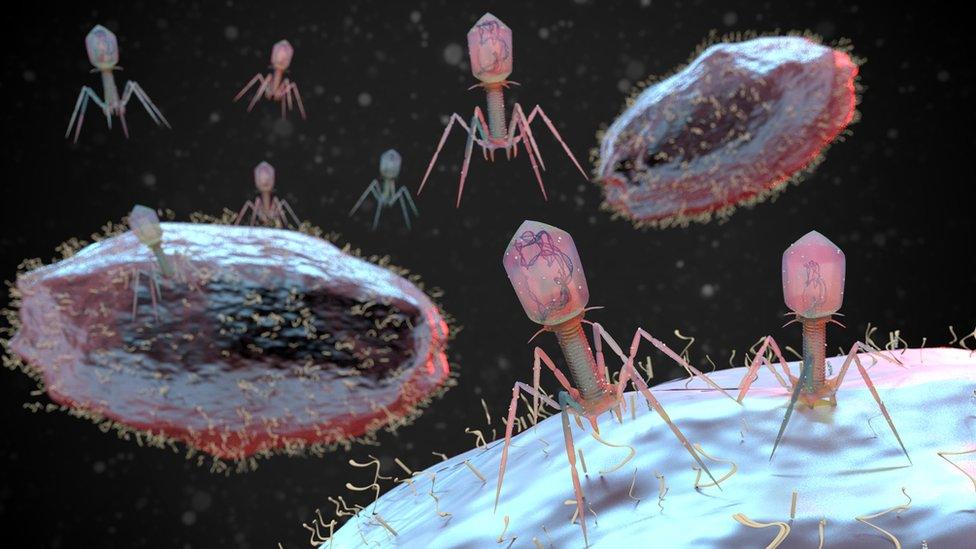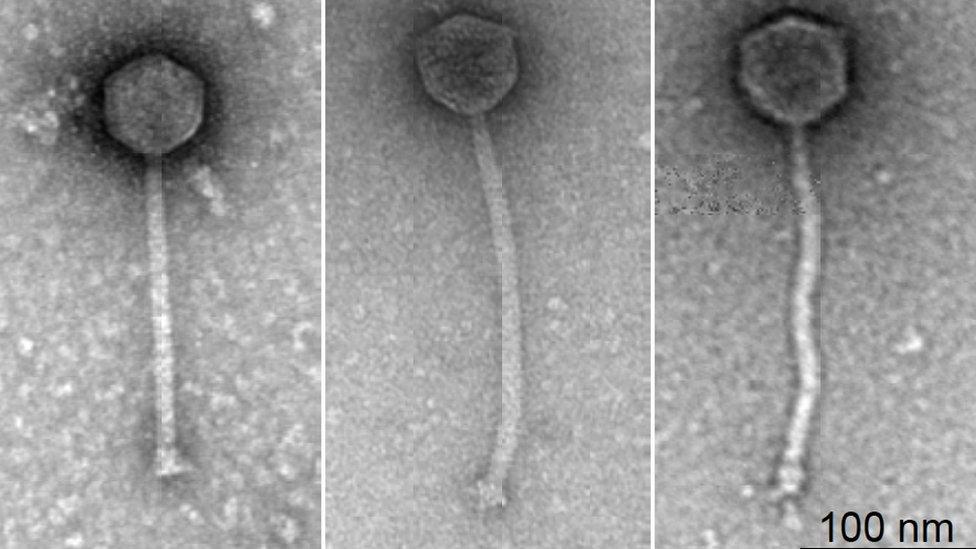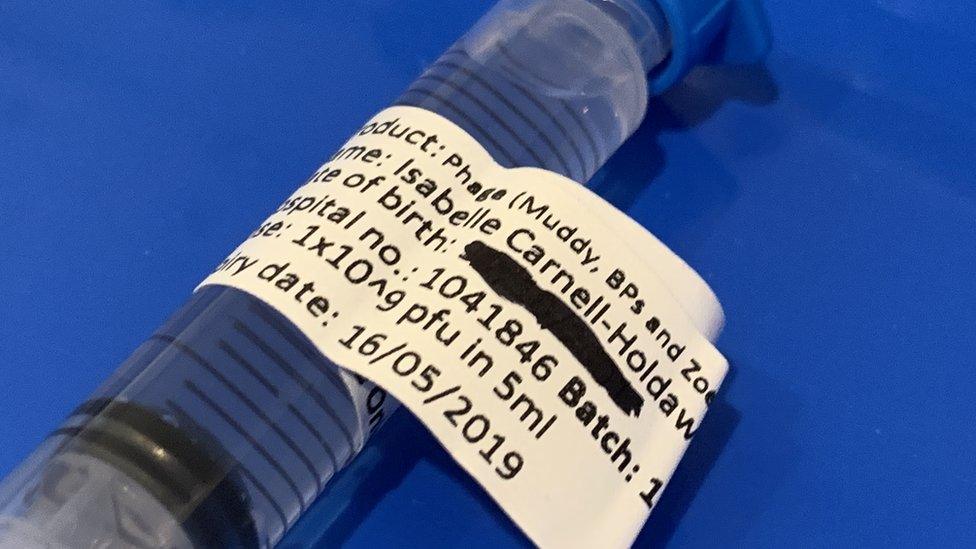Phage therapy: 'Viral cocktail saved my daughter's life'
- Published

Isabelle Carnell-Holdaway is now 17 and learning to drive
An experimental cocktail of viruses has saved the life of a teenager who had a deadly and seemingly untreatable infection.
Isabelle's body was being attacked by bacteria and she was given less than a 1% chance of survival.
But doctors at Great Ormond Street Hospital attempted an untested "phage therapy", which uses viruses to infect and kill bacteria.
Isabelle is now learning to drive and studying for her A-levels.
Experts said the case was "enormously exciting" and showed the potential for treating other dangerous infections with phage.
What are phages?
They are the microbial embodiment of the adage: "My enemy's enemy is my friend."
Phages, also known as bacteriophages, are a type of naturally occurring virus that infects bacteria rather than the body's own cells.
Looking like sinister aliens, they land on the surface of a bacterium and inject their own genetic code.
This hijacks the bacterial cell, turning it into a phage factory until the viruses eventually burst out of the cell.

Bacteriophage infect bacterial cells, replicate inside them and destroy the bacterium
Why did Isabelle need them?
Isabelle Carnell-Holdaway was born with cystic fibrosis. It causes sticky mucus to develop inside her lungs, which can harbour dangerous infections.
A relative of tuberculosis - Mycobacterium abscessus - infected her body and she needed potent antibiotics to keep it in check.
When she was 16, she needed a double lung transplant, but the bacteria were still hiding in her body.
When she started immunosuppressant drugs to prevent her rejecting the transplant, the infection came back.
Her doctor, Helen Spencer, said: "For patients with re-growth of Mycobacterium after transplant, in our experience, all have gone on and died.
"For some patients, that's within a year despite aggressive treatment."
Isabelle had big, black, festering lesions forming on her skin where the infection was taking hold.
And she ended up in intensive care when her liver started failing, with large colonies of bacteria forming in her body.
Doctors said there was nothing they could do, and that Isabelle had a less than 1% chance of survival.
Her parents decided to take her home where she would be surrounded by family.
Where did the experimental therapy come from?
The idea for attempting phage therapy came from Isabelle's mother, Jo, who had been researching alternatives on the internet.
The team at Great Ormond Street contacted Prof Graham Hatfull, at the Howard Hughes Medical Institute, in the US, who had the world's largest collection of phages.
He had about 15,000 vials of phage but it took months to work out which combination of phages might work against Isabelle's infection.
The US team settled on three phages - two of which they genetically modified to make them more effective.

The three phage used to treat Isabelle.
The therapy was injected into her blood stream twice a day and applied to the lesions on her skin, according to the journal Nature Medicine, external.
How good were the results?
Isabelle's mum, Jo, noticed the difference within weeks. She is in no doubt her daughter's life was saved by the viruses.
Isabelle's lesions started to heal and some wounds that had been open for months started to close.
Jo told BBC News: "When we left hospital, she literally looked like a skeleton with skin on, she was so poorly.
"It was absolutely incredible the effect the phage had on her.
"She's got back her own life, the life of a 17-year-old girl."
Isabelle went back to school in September, passed her GCSE maths and is now studying for her A-levels.
She's also learning to drive.
She told the BBC: "It's an incredible thing, it's still working slowly, it's just great being able to do all these things on my own without having any problems."
Is she cured?
Isabelle's fatal infection has not been completely cured - but it is under control.
She is still having two infusions of the viral cocktail every day.
And the family are waiting for a fourth phage to be added to the mix in an attempt to clear her of the infection completely.

This vial contains the mix of phages that are treating Isabelle's infection.
Dr Spencer told BBC News: "It's amazing really, but also tinged with sadness when I think of all the patients that did not survive as the treatment was not available in time for them."
Isabelle's story is remarkable, but also only a single case.
Technically, scientists cannot be certain how effective the phage is without performing clinical trials.
Dr Spencer added: "We have to be really cautious about extrapolating a single individual case to other patients and what it might mean for them.
"But I think it does encourage future research into phage therapy for some of those resistant bacteria that we're really becoming concerned about."
Is phage therapy new?
No, some doctors have been using phages for nearly a century.
The field developed in Georgia and other countries in the former USSR, but never became mainstream medicine.
Phage-therapy was eclipsed by the discovery of antibiotics, which are much easier to use.
One antibiotic can work across a broad range of bacterial infections, while phage-therapy requires finding the precise phages that will attack each infection.
But now phage-therapy is having a resurgence due to the rise of superbugs that are resistant to antibiotics.
What does this mean for other infections?
This is the big question and at the moment there is no clear answer.
Prof Graham Hatfull, from the Howard Hughes Medical Institute, said: "We're sort of in uncharted territory.
"The idea is to use bacteriophages as antibiotics, as something we could use to kill bacteria that cause infection."
But to use phage more widely would require careful matching of phages to a patient's infection.
Prof Martha Clokie, a phage researcher at the University of Leicester, told BBC News: "I think that this work is enormously exciting.
"It shows how bacteriophages can be successfully developed as therapeutics even in very difficult circumstances where bacteria are resistant to many antibiotics and the bacteria are difficult to treat.
"I think it will pave the way for other such studies and help with getting the necessary trials carried out on bacteriophages so that they can be used more widely to treat humans."
Follow James on Twitter., external